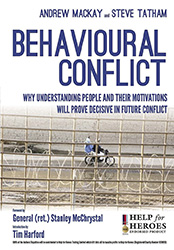BOOK REVIEWS

Behavioural Conflict – Why Understanding People and their Motivations will Prove Decisive to Future Conflict
by Major General Andrew Mackay (ret’d), and Commander Steve Tatham
UK: Military Studies Press, 2011
220 pages, $29.95
ISBN 13-978-1-73039-468-8
For more information on accessing this file, please visit our help page.
Reviewed by Rita LePage
Behavioural Conflict is written by two, seasoned British military officers—Army Major General Andrew Mackay, who commanded 52 Brigade in Helmand Province, Afghanistan, and Navy Commander Steve Tatham, PhD, CO of 15 PSYOPS Group, and it is based on their work in preparing 52 Brigade to deploy—specifically in the area of influence operations. While the authors discuss previous conflicts, from the Balkans in the 1990s, Sierra Leone, Lebanon, and Gaza, to the Iraq war, 52 Brigade’s ISAF deployment is the case study upon which the book revolves.
The authors describe how they addressed 52 Brigade’s pre-deployment training in subject areas that received little attention in previous deployments—influence operations. The reality that their soldiers had little understanding of the culture into which they were deploying—and therefore were inadequately equipped to understand and predict let alone influence behaviours—drove the requirement for enhanced training in the areas of social psychology, anthropology, and behavioural economics.
Mackay and Tatham collaborated to do extensive Target Audience Analysis (TAA) of the local population with which their soldiers would interact. The goal was to understand the population as a group—not simply to understand attitudes, but to understand motivation, ultimately seeking to design a campaign with the goal of changing behaviour. The behaviour they sought to change was anything negatively impacting the mission while reinforcing positive behaviour. An important part of the campaign design was to delegate to the lowest level, the soldier, the ability to apply influence based on events, activities, sentiment, and circumstances at play at the time.
The book presents statistics which suggest significant success. Using TAA as the basis for understanding societal motivation towards behavioural change, 52 Brigade, during its deployment, suffered 13 killed in action—.16 percent deaths in relation to the size of its deployment. This is then compared with the percentage of deaths in UK deployments in the same area of responsibility before and after 52 Brigade which experienced .73 percent, .25 percent, .43 percent, .30 percent, and .38 percent fatal casualties respectively. 52 Brigade suffered half the deaths of some deployments, and as much as four times fewer deaths than others.
US General Stanley McCrystal, in the Foreword to the book writes, “…most counterinsurgency is local. Andrew Mackay and Steve Tatham never lose sight of this in their study on the role of individual motivation and behaviour in conflict …In war, they have seen what it takes to alter behaviour up close—and it shows.”
The Canadian Armed Forces lag behind many (if not all) our closest allies in the development of a capability which, in conflicts such as Afghanistan, seeks to bring influence to the forefront of campaign planning and execution. While nations such as the UK, US, Germany, Denmark, France and others, as well as NATO, have invested considerable resources into the development and implementation of Influence and Strategic Communication (StratCom)—think of it as “operations in the information environment”—the CAF has done little forces-wide to study, adapt, and adopt the concept. There are pockets of activity. The Influence Activities Task Force (IATF) at Land Force Doctrine and Training System Headquarters (LFDTS HQ) in Kingston, Ontario, stands out as a leading initiative in this emerging area of operations, but throughout the CAF the concept is little known, and even less studied.
Every CAF member should get interested, and quickly, and to this end, I highly recommend Behavioural Conflict. The book explores an important element of modern conflict: that the extant practice of influence activities in particular and StratCom more generally being a second thought, an add-on, to kinetic operations, might be ‘getting the whole thing wrong.’ Mackay and Tatham make a credible argument for influence-led operations, of which kinetic operations are only a part.
And the CAF should take notice.
Lieutenant-Colonel LePage is the Director of Public Affairs Operations (Military Strategic Communication) at ADM(PA), NDHQ, and has spent the past three years developing NATO’s Strategic Communication capability at the Supreme Headquarters Allied Powers Europe (SHAPE).



